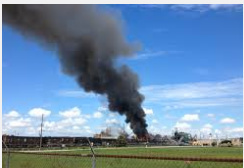I’ll be venting out a window. Do I have to worry about people thinking there’s a fire? 
You should not see visible smoke out of the window vent. The amount of visible vapor or smoke from cutting is not high and by the time it gets mixed into the volume of air being exhausted through the vent I doubt it will even be visible except maybe during the winter.
Okay Phew. I kind of figured so, but wanted to check! Thanks!
Burning 1/4" wood will be the most. It will be mixed with air assist. neighbors may smell something. Do they barbecue or spray insecticides, burn trash? There are many things neighbors do that are worse. - Rich
Haha! Okay cool. Hopefully I wont get in trouble. 
Will odor in the vented air be a problem? I live in a townhome with neighbor’s windows 20-40 feet away and will be venting at ground level.
Acrylic smells not pleasent as does natural things like leather and bone.
Wood shouldn’t be a problem since alot of people burn wood so the smell is familiar.
IMO cardboard stinks pretty bad too so hope you dont get too many complaints. I’m in an industrial park and I vent to the 20 ft roof so no problem…lol
You can always cut in the middle if the night😏
One option might be to connect the GF vent to the 3-in radon abatement pipe that runs up to the roof, but I’m not sure that’s a good idea and will need to do a bit of research on that approach.
To run it through a longer pipe, it will need a fan. I have a large blower that pulls it up that far.
The abatement system has its own in-line fan, but that will be above the GF tie-in point. I’ll need to do some calculations to check pressure drop vs flow rate.
Anybody know what the nominal flow rate from the GF vent line will be? I don’t suppose @dan would divulge the technical specs on the GF vent fan/blower or provide manufacturer and model number for it?
Fantastic!! Thanks guys!! I’m in an apartment so venting to the roof won’t be an option  I am on the top floor in the corner… so hopefully that’ll help.
I am on the top floor in the corner… so hopefully that’ll help. 
Smoke rises so you should be gold then.![]()
The radon system was my original plan. I wouldn’t think the amount of time the laser is running would be an issue in terms of lessening the flow. There will still be a negative pressure, just reduced.
Just have a blast gate to isolate the laser so when not in use the radon system will return to it’s peak flow.
Getting that exhaust upon the roof is ideal. You ever get close to any vent pipes up there? WHEW 
But you never smell it on the ground. Dispersal FTW!
Sombody’s using their new laser…

j/k 
You won’t see it at all, but as mentioned you can smell it if you’re close to the vent.
This is a somewhat of a related question. (@dan)
As this mostly about in-line boosters vs. just venting out of a window.
Since the Glowforge Basic (And Pro) use the fume exhaust as the same subsystem/outlet as the cooling exhaust. Does this mean folks with a booster (in-line active fan used for longer runs) would get marginally or possibly better cooling performance then dumping directly out of a window using the stock built-in exhaust fan? Which would lead to longer cuts times or faster recoup times? Does this also apply to Basic units with the Glowforge Filter unit?
Secondly, Since those two subsystems share the same exit point- Do we end users have to worry about degraded cooling performance overtime? i.e. cutting nothing but wood for let just say 6 months. Will there be deposits on the radiator (or whatever is used as the heat exchange) which would reduce cooling efficiency? Is that something that enduser cleanable? Or that subsystem is not in direct contact with the fume exhaust side? Now mind you- I have no idea how that is laid out internally- But inquiring minds would like to know.
Good question. Considering the fume/resin deposits on the tray, it would seem reasonable to have the heat exchanger immediately downstream of the case air intake.
My concern is that the flow rate coming out the 3-in GF vent hose may induce enough pressure in the 3-in radon abatement pipe that some of the flow will flow backwards through the radon vent and be exhausted into the space under our concrete slab. To get a better idea I need to know the GF vent exhaust flow rate and the flow rate from the radon abatement fan.
I can get the latter myself, but only GF can supply the latter and @dan hasn’t done that so far, so I may have to wait until mine arrives to do the needed calculations. Not a huge deal since it is cool enough here in the Chicago suburbs that neighbors are unlikely to have open windows for a few months and it appears that smoke won’t be visible.
I see. If the slab is flatwork, that is if it poured on the ground, there should be minium void for backflow. The mitigation systems I am familiar with on flatwork draw from the sump pump void.
The soil’s radon production rate is slow, and it is extended exposure that is the potential issue. I bet you will be fine, but knowing the values of the two systems would be reassuring.
It’s my anal nature - I like to run calculations on anything like this. Used to drive my co-workers nuts but every once in a while it would reveal a problem that needed addressing, usually of a safety nature.